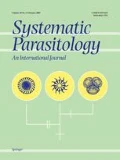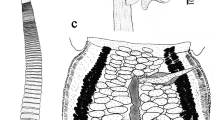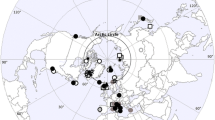Abstract
A comparison of specimens previously identified as Bashkirovitrema incrassatum (Diesing, 1850) from the African or cape clawless otter Aonyx capensis, and the speckle-throated or spotted-throated otter Hydrictis maculicollis from the Old World with specimens and descriptions of B. incrassatum from the New World showed that those from Africa (Bashkirovitrema africanum n. sp.) had a more extensive distribution of the vitelline fields than either B. canadense n. sp. from the northern river otter Lontra canadensis and the American mink Neovison vison (North America) and B. incrassatum from the Neotropical river otter Lontra longicaudis (South America). B. africanum n. sp. further differs from B. canadense n. sp. by having a smaller body, shorter forebody, smaller oral sucker, longer cirrus, shorter intertesticular space, shorter post-testicular space and longer eggs. B. canadense n. sp. can be distinguished from B. incrassatum by having a longer body, longer forebody, smaller sucker ratio, smaller testes, greater distance between the ventral sucker and the ovary, shorter cirrus-sac, longer post-testicular space and narrower eggs. B. africanum n. sp. differs from B. incrassatum by having a smaller ventral sucker, larger ovary, shorter cirrus-sac, smaller intertesticular space, larger post-testicular space and longer eggs that are not as wide. Kostadinovatrema n. g., as represented by K. novaeguiniense n. sp., can be separated from species of Bashkirovitrema Skrjabin, 1944 by having a wider body width to length profile, a head collar that is narrower than the forebody and armed with 33 rather than 27 collar spines, an ovary that is further removed anteriorly from the testes, and a dorso-ventrally flattened hindbody that is nearly as broad as the forebody. The new genus differs from Hypoderaeum Dietz, 1909 and Moliniella Hübner, 1939 by having 33 head collar spines.




Similar content being viewed by others
References
Beverly-Burton, M. (1960). Some trematodes from otters in southern Rhodesia including a new strigeid, Prudhoella rhodesiensis, n. gen., n. sp. Proceedings of the Helminthological Society of Washington, 27, 129–134.
Braun, M. (1901). Zur Kenntniss de Trematoden der Säugetiére. Zoologische Jahrbücher für Systematik, Ökologie und Geographie der Tiere, 14, 311–348.
Cockrum, E. L. (1964). Southern river otter, Lontra annectens, from Sonora, Mexico. Journal of Mammalogy, 45, 634–635.
Diesing, K. M. (1850). Systema helminthum. Vol. 1. Braumüller: Vindobonae, 679 pp.
Fleming, W. J., Dixon, C. F., & Lovett, J. W. (1977). Helminth parasites of river otters (Lutra canadensis) from southern Alabama. Proceedings of the Helminthological Society of Washington, 44, 131–135.
Forrester, D. J. (1992). Parasites and diseases of wild mammals in Florida. Gainesville: University Press of Florida, 459 pp.
Groves, C. P. (2005). Peramelemorphis. In D. E. Wilson & D. M. Reeder (Eds.), Mammal species of the world. Vol. 1. Baltimore: The Johns Hopkins University Press, pp. 39–40.
Kollars, T. M., Lizotte, R. E., & Wilhelm, W. E. (1997). Gastrointestinal helminths in the river otter (Lutra canadensis) in Tennessee. Journal of Parasitology, 83, 158–160.
Kostadinova, A. (2005). Family Echinostomatidae Looss, 1899. In A. Jones, R. A. Bray, & D. I. Gibson (Eds.), Keys to the Trematoda. Vol. 2. Wallingford: CABI Publishing and The Natural History Museum, pp. 9–64.
Krasnolobova, T. A., & Sergeeva, T. P. (1964). Baschkirovitrema skrjabini n. sp. (Trematoda: Echinostomatidae) from gulls. Trudy Gel’mintologicheskoi Laboratorii Akademiya Nauk SSSR, 14, 119–121. (In Russian).
Larivière, S. (1999a). Lontra longicaudis. Mammalian species, 609, 1–5.
Larivière, S. (1999b). Mustela vison. Mammalian species, 608, 1–9.
Larivière, S. (2001a). Aonyx capensis. Mammalian species, 671, 1–6.
Larivière, S. (2001b). Lontra maculicollis. Mammalian species, 712, 1–6.
Larivière, S., & Walton, L. R. (1998). Lontra canadensis. Mammal Species, 587, 1–8.
McIntosh, A. (1940). Some helminth parasites of the Panama otter. Journal of Parasitology, 26, 219–221.
Miller, G. C., & Harkema, R. (1964). Studies on helminths of North Carolina Vertebrates. V. Parasites of the mink, Mustela vison Schreber. Journal of Parasitology, 50, 717–720.
Myers, B., Wolfgang, R. W., & Kuntz, R. E. (1960). Helminth parasites from vertebrates taken in the Sudan (East Africa). Canadian Journal of Zoology, 38, 833–836.
Redford, K. H., & Eisenberg, J. (1998). Mammals of the Neotropics. 2. The Southern Cone. Chicago: University of Chicago Press, 430 pp.
Sawyer, T. K. (1961). The American otter, Lutra candensi vaga, as a host for two species of trematodes previously unreported from North America. Proceedings of the Helminthological Society of Washington, 28, 175–176.
Shoop, W. L., & Corkrum, K. C. (1981). Some trematodes of mammals in Louisiana. Tulane Studies in Zoology and Botany, 22, 109–121.
Skrjabin, K. I. (1944). An analysis of the generic components entering into the composition of three trematode families: Opisthorchiidae, Dicrocoeliidae and Echinostomatidae. Doklady Akademii Nauk SSSR, 44, 299–301. (In Russian).
Stossich, M. (1892). I distomi dei mammiferi. Progamma Della Civica Scuola Reale Superiore in Trieste. Trieste: Stabilimento Artistico Tipografico G. Caprin, 42 pp.
Whitaker, J. O., & Hamilton, W. J. (1998). Mammals of the eastern United States (3rd ed.). Ithaca: Cornell University Press, 583 pp.
Wozencraft, W. C. (2005). Carnivora. In D. E. Wilson & D. M. Reeder (Eds.), Mammal species of the world. Vol. 1. Baltimore: The Johns Hopkins University Press, pp. 601–619.
Yamaguti, S. (1971). Synopsis of digenetic trematodes of vertebrates. Vol. 1. Tokyo: Keigaku Publishing Company, 1074 pp.
Zhatkanbeava, D. (1971a). Rare species of trematodes from fish-eating birds in Kazakhstan. Materialy Nauchnykh Konferentsii Vsesoyuznogo Obshchestva Gel’mintologov 1969–1970, 23, 106–109. (In Russian).
Zhatkanbeava, D. (1971b). Helminths of Larus ichthyaetus in Kurgal’dzhinsk Lakes. Trudy Instituta Zoologii, 31, 51–59. (In Russian).
Acknowledgments
I thank the Texas Parks and Wildlife Department and the US Fish and Wildlife Service, whose cooperation made this study possible. I also thank Drs Scott Gardner and Augustín Jiménez, the Harold W. Manter Laboratory, University of Nebraska, Lincoln, Nebraska; Dr Eric Hoberg and Mrs Patricia Pilitt, the United States National Parasite Collection, Beltsville, Maryland; and Mrs Eileen Harris, Natural History Museum, London, UK for allowing us to examine specimens of Bashkirovitrema and other echinostomes from their holdings. Special thanks go to Dr Aneta Kostadinova of the Department of Biodiversity, Central Laboratory of General Ecology, Bulgarian Academy of Sciences, Sofia, Bulgaria for her assistance in the interpretation of echinostome characteristics and her comments concerning the preparation of this manuscript, and to Dr Ifor Owen of the National Veterinary Laboratory, National Agriculture Quarantine & Inspection Authority, Port Moresby, Papua New Guinea for the collection of specimens of Kostadinovatrema n. g. and for providing additional information on the host. This study was part-funded by a grant from the Schubot Exotic Bird Research Center, the Texas Veterinary Center, Texas A&M University.
Author information
Authors and Affiliations
Corresponding author
Rights and permissions
About this article
Cite this article
Dronen, N.O. Re-evaluation of the species composition of Bashkirovitrema Skrjabin, 1944 (Digenea: Echinostomatidae), with the description of two new species of this genus and the proposal of Kostadinovatrema novaeguiniense n. g., n. sp.. Syst Parasitol 74, 169–185 (2009). https://doi.org/10.1007/s11230-009-9216-4
Received:
Accepted:
Published:
Issue Date:
DOI: https://doi.org/10.1007/s11230-009-9216-4




